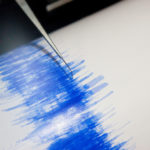Transient Lunar Phenomena

WHAT ARE TRANSIENT LUNAR PHENOMENA?

For centuries, people have reported seeing flashing lights on the moon. They come in different colors, all emanating from a specific area of the moon. The activity is intermittent. An amber colored light may suddenly appear and then disappear just seconds later.
Once telescopes were invented in 1608, astronomers became even more fascinated with the intermittent flashing lights.
The majority of this activity is around Aristarchus, a crater almost the size of the Grand Canyon.
What is this translunar phenomenon, more commonly known as transient lunar phenomenon? Could extraterrestrial life have anything to do with it?
In 1966, a transient lunar phenomena report was compiled for NASA by four of the top scientists and astronomers of the time. Barbara Middlehurst, a well-known astronomer, worked with her team member, Patrick Craig, and others. They prepared a detailed chronology of lunar events that occurred from June 1950 to October 1967. The report was published in 1968, prior to the first moon landing.
Middlehurst provided detailed documentation on sightings of moving objects, flashing lights and many other odd events on the lunar surface. About 60 percent of the activity was around Aristarchus or based on activity coming from the crater itself. Some examples of her entries include the following:
- October 25, 1966: “Large bright area obscuring half of crater wall. It was not present on Oct. 24″
- April 22, 1967: “Aristarchus so bright that it could be seen by the naked eye”
- August 13, 1967: “Glow in interior in crater”
Naturally, the crater was an area of interest once manned missions to the moon began. Many audio tapes and photos of the moon missions, particularly the most important ones from Apollo 11, are mysteriously missing.
One copy of a debriefing log taken after the astronauts had returned from their first landing on the moon reveals a conversation with astronauts Neil Armstrong, Edwin “Buzz” Aldrin, Michael Collins and an unknown speaker. They discussed that one request had been for them to look at the crater Aristarchus to see if they “could see any glow or evidence of observations that had been made by people on the ground.”
Aldrin concluded that the lights around and emanating from Aristarchus were brighter “than anything else we could see in either direction.” They also mentioned that the photos taken during the trip could shed light on what they had seen. But, the photos are either missing or of such poor quality it is difficult to use them in a meaningful way.
In 1994, a joint task force between NASA and the Strategic Defense Initiative Organization sent a probe to the moon as part of their Clementine Project. The probe had several tasks, one of which was to fly over the Aristarchus Crater and take photos. Astronomers who viewed the photos reported seeing a clearly visible blue dome-shaped structure when the Aristarchus “lights are on.”
Even though the photos are in low resolution and highly pixelated, astronomers believe there is a dome structure in the Aristarchus Crater. One photo, dated September 7, 2007, shows an “electric blue” color emanating from the crater with “dome like structures” in the crater itself.
There is a strong indication that the dome-shaped structure is a fusion reactor. A former NASA manager of the photo department claims that the government has evidence of ancient alien cities on the moon. These were discovered mostly during the Apollo program. If there is evidence of ancient cities, could the activity around the Aristarchus Crater indicate current extraterrestrial life?
Secret Space Programs and Breakaway Civilizations

In July 2014, on the 45th anniversary of Apollo 11’s moon landing, the government declassified information about a secret space program from the 1950s called Project Horizon. The plan outlined the building of a permanent military base on the moon. Ten to twenty men would be sent with all their supplies and nuclear weapons. The secret moon base would be used for surveillance against and protection from the Soviet Union, and the men would have constant communication with the Earth.
The released documents show that the scientists knew it wasn’t possible to implement the plan, but it was expected to be put in place as technology advanced. Project Horizon never got off the ground. But, that isn’t the end nor the beginning of the story about secret space programs from the past, present and the future.
Secret Space Programs and FDR
In the 1940s, according to recently released documents, President Franklin Delano Roosevelt commissioned a secret space program. He was concerned about how to move large numbers of people in case of nuclear war to avoid massive radiation damage. He thought there might also be a need to escape the ravages of some other global cataclysmic event. Since there was no place on Earth to which large masses of people could be moved, he considered the possibility of moving to locations in space.
At first, moving to the nearest star, Alpha Centauri, seemed like an option. However, the distance made such a plan impossible. As a next step, FDR focused on the moon, Mars or Venus as alternatives to Earth.
Beginning in 1945 at the conclusion of WWII, after President Truman took over, he brought 1,500 German scientists and engineers to the U.S. The scientists, under Hitler’s leadership in Nazi Germany, made advancements in the development of flying saucers, like the Nazi Bell, before and during the war. The German scientists worked at Fort Bliss, near El Paso, Texas, and were assigned the task of developing secret space programs under the project name of Operation Paperclip.
Truman believed the Germans had knowledge of anti-gravity propulsion engines and other spacecraft flight technology. Werner von Braun was the most well-known member of this group, who eventually became the designer of the Saturn V launch vehicle, which was used to propel American astronauts to the moon. He eventually became the director of NASA’s Marshall Space Flight Center and spoke out frequently about the need for space exploration.
Secret space programs are believed to be financed by secret “Black Budget” programs with contributions made by people with great wealth, private contractors and some government agencies. This secret funding keeps the programs from being subject to congressional oversight. Since the early 1960s, the programs have been kept secret even from the president: A memo was found in the newly released documents that said to keep “Lancer,” President Kennedy’s secret service nickname, out of the loop.
Secret Space Programs and Breakaway Civilizations
Secret space programs may have developed Breakaway Civilizations in outer space. Well-respected UFO and space researcher Richard Dolan, defines a Breakaway Civilization as a secret group of technologically advanced people who don’t share their knowledge with the rest of the world. These are essentially the Earth’s elite who have knowledge far above the rest of the world.
These elite may know of an upcoming imminent global geological cataclysm event and are building space bases as shelters for themselves. For example, they could be planning their escape from Nibiru Planet X, which “triggers comet showers” every 27 million years. One of those comets is expected to crash into the Earth and totally destroy it sometime in the not too distant future.
Scotland native, Gary McKinnon, hacked into thousands of government secret files. He found evidence of an anti-gravity propulsion system that traveled at incredible speeds. Also, he found evidence of portal technology that, when coupled with anti-gravity propulsion, would allow space travel to other stars and planets to be accomplished in a short amount of time.
It appears that Einstein’s theory that nothing can travel faster than the speed of light has been debunked. It also appears the Black Budget keeps these secrets even from NASA, since NASA apparently does not have access to anti-gravity technology. It still propels its rockets with fossil fuel.
McKinnon claims he saw nearly 300 photos of structures and civilizations existing on the back side of the moon. He says these structures (alien bases on the moon) are erased out of any photos when they are released to the public. Unfortunately, when he hacked into the computers, he was using a dial-up connection so he couldn’t download the photos. He says he took a screenshot of one that was saved on his computer, but his computer was seized when he was arrested. When his computer was subsequently returned to him, the photo was gone.
McKinnon also reported viewing a file that included names of “non-terrestrial officers” who he says were assigned to ships that weren’t U.S. Navy ships. He concluded these were the officers assigned to space ships, not navy ships, indicating that Breakaway Civilizations already exist.
There are many outstanding questions about secret space programs. Why do these programs remain secret? Will there be an opportunity for non-elite citizens to be part of a Breakaway Civilization? A poll taken in 2015 shows that 54 percent of Americans believe extraterrestrial intelligence exists. With such a large number of people supporting alien existence, why is there still a need to maintain secrecy?
Want more like this article?
Don’t miss Deep Space on Gaia for more on the long and hidden history of Earth’s secret space program.










































